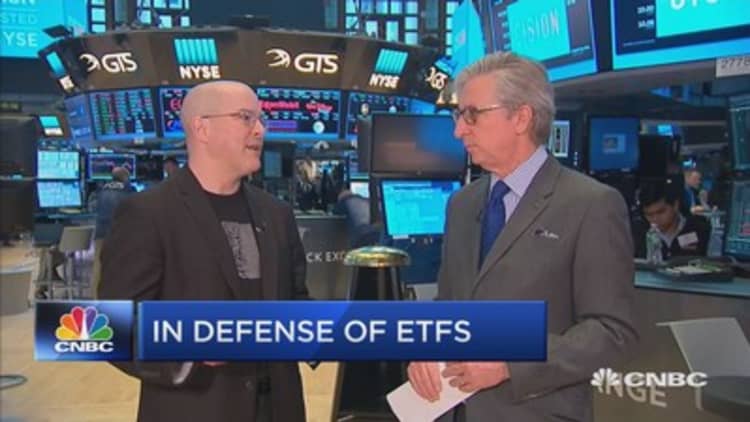
ETFs enter the second half of the year with record inflows of $247 billion and record assets under management of $2.971 trillion. Inflows have been positive for 16 straight months.
June saw the continuation of many of the big trends for the year. The biggest inflows remain in plain-vanilla assets such as and Russell 2000 funds, but big money has also been flowing into international and emerging market funds.
ETFs: June biggest inflows
iShares Core S&P 500
iShares Russell 2000
Vanguard Europe
iShares Emerging Markets
Source: etf.com
What about smart beta? It's been a media darling, with tons of hype, but it isn't attracting investor interest. "You can't go in a subway without seeing an ad for a smart beta fund, but not a single smart beta has cracked the top 75 in terms of flows," Dave Nadig, CEO of ETF.com, told me.
For the year so far, money is still going into U.S. equity and U.S. fixed income ETFs, but a lot of investors have moved money into overseas funds. International and fixed income both saw strong inflows.
ETFs 2017: Where the money is going
(increases in AUM)
US Equity up 4.8%
US Fixed Income up 12.3%
International Equity up 13.7%
International Fixed Income up 21.4%
Source: etf.com
But there are signs momentum is starting to shift against the tech sectors. In June, there were outflows from the main NASDAQ 100 ETF (QQQ), and we saw particularly large outflow from a semiconductor ETF (SMH). Gold miners also saw outflows.
As for who is getting the money — the big guys keep getting bigger. While there are north of 70 ETF providers, the Big Four (BlackRock, Vanguard, State Street and Invesco PowerShares) together control 88 percent of the total assets under management of the ETF business.
ETFs: the big guys
(AUMs)
BlackRock $1.17 trillion
Vanguard $734 billion
State Street $540 billion
Invesco PowerShares $124 billion
Source: etf.com
Not only are the biggest fund companies getting bigger, so are the funds themselves. There are more than 2,000 ETFs in the United States, but most of the assets are in the top 100:
ETFs: where's the money?
(% of assets under management)
Top 30 50%
Top 100 75%
Finally, there is evidence that investors are VERY sensitive to fees, down to levels that seem, well, kind of trivial. As an example, take two funds that are essentially identical: the iShares Core S&P 500 and the SPDR S&P 500.
Both own the S&P 500. But the IVV charges 4 basis points a year. It's had $16.8 billion in inflows this year.
The SPY charges 9 basis points a year. It's had OUTFLOWS of $5.6 billion.
Huh? Investors are moving money around for a 5 basis point difference? Just to give you an idea of what I'm talking about, 5 basis points is $0.50 a year for a $1,000 investment. That's $500 for a $1,000,000 investment. Investors are that sensitive?
"The attitude is, 'It's $500 of free money," Nadig told me. "If you have $1 million in a fund, and you can save $500 a year just by transferring it to a different fund that does the same thing, why shouldn't you?"
Finally, what about the big debates about passive vs. active management? "It's not so much about active versus passive, it's about lower costs," Nadig told me, and passive funds are cheaper than active, even in ETF land.
And the much-debated issue that too much money is going into passive ETFs? Nadig has two responses: "One, we're seeing a lot of growth in actively managed ETFs, so if you're worried about nobody getting the price of Google right because there are no active traders, I think you're seeing that happen in ETFs, and I think that's healthy.
"The other thing is, ETFs only own 6 percent of U.S. equities. That's a pretty small number compared to, say, 401(k) plans."


